EVAL-ADXL355-PMDZ User Guide
Overview
The EVAL-ADXL355-PMDZ is a compact, low-cost, Pmod-compatible evaluation board for the ADXL355 low noise density, low zero-g offset drift, low power, 3-axis MEMS accelerometer with selectable measurement ranges. The ADXL355 supports the ±2g, ±4g, and ±8g ranges, and offers industry leading noise, offset drift over temperature, and long term stability, enabling precision applications with minimal calibration and with very low power consumption. Applications include:
Inertial measurement units (IMUs)/altitude and heading reference systems (AHRS)
Platform stabilization systems
Structural health monitoring
Seismic imaging
Tilt sensing
Robotics
Condition monitoring
The ADXL355 accelerometers offer guaranteed temperature stability with null offset coefficients of 0.15mg/°C (max). The stability minimizes resource and expense associated with calibration and testing effort, helping to achieve higher throughput for device OEMs. In addition, the hermetic package helps ensure that the end product conforms to its repeatability and stability specifications long after they leave the factory.
With output of ±2g to ±8g full scale range (FSR), selectable digital filtering from 1 Hz to 1 kHz, and low noise density of 25µ/√Hz at less than 200µA current consumption, ADXL355 MEMS accelerometer offers performance level comparable to much more expensive devices with less power consumption and BOM cost.

Input and Output Connections and Configurations
The PMOD board is small in size with dimensions approximately 2.5 cm in width by 2.5 cm in length.
Pmod Processor Connector
The PMOD interface is a series of standardized digital interfaces for various digital communication protocols such as SPI, I2C, and UART. These interface types were standardized by Digilent, which is now a division of National Instruments. Complete details on the Pmod specification can be found on the Digilent Pmod landing page.
The specific interface used for the EVAL-ADXL355-PMDZ boards is the extended SPI. In general ADI has adopted the extended SPI connector for all PMOD devices which have an SPI interface. It provides flexibility to add interrupts, general purpose I/O, resets, and other digitally controlled functions.
P1 Pin Number |
Pin Function |
Mnemonic |
P1 Pin Number |
Pin Function |
Mnemonic |
|---|---|---|---|---|---|
Pin 1 |
Chip Select |
CS |
Pin 7 |
Interrupt 1 |
INT1 |
Pin 2 |
Master Out Slave In |
MOSI |
Pin 8 |
Not Connected |
NC |
Pin 3 |
Master In Slave Out |
MISO |
Pin 9 |
Interrupt 2 |
INT2 |
Pin 4 |
Serial Clock |
SCLK |
Pin 10 |
Data Ready |
DRDY |
Pin 5 |
Digital Ground |
DGND |
Pin 11 |
Digital Ground |
DGND |
Pin 6 |
Digital Power |
VDD |
Pin 12 |
Digital Power |
VDD |
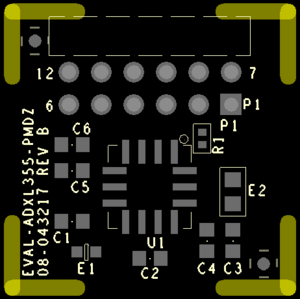
ADXL355 Interrupt Pins
The EVAL-ADXL355-PMDZ has two interrupt pins and a data ready pin which can be used as external indicators for the user. The interrupt pins can be programmed through software to reflect various status flags within the ADXL355, and those pins are accessible through the SPI PMOD header. For complete details on the individual status flags, what they mean, and how to program the chip to reflect those interrupts, please consult the ADXL355 data sheet.
Power Supply Considerations and Configuration
When using the ADXL355 PMOD board, the 3.3V power for the PMOD comes directly from the host board it is connected to. Most Pmod platform boards can supply at least 100 mA, more than adquate for the EVAL-ADXL355-PMDZ.
Device Driver and Software Support
There are two device driver and accompanying software solutions provided for the EVAL-ADXL355-PMDZ:
ADXL355 no-OS Driver
The ADXL355 no-OS driver is used in bare-metal applications, typically running on low-power, embedded microcontrollers.
The ADXL355 no-OS example project uses the ADXL355 no-OS driver and has several configuration options:
The tinyiiod configuration emulates the Linux IIO framework through the tinyiiod daemon library. The application communicates with the host computer via the serial backend, over a USB-UART physical connection. This facilitates rapid application development on a host computer, independent from embedded code development. This is the configuration that will be referenced in the no-OS platform setups below.
The “dummy” configuration implements a simple command-line program that can be run on a terminal.
Download
A zip file containing prebuilt programming files for the no-OS example project, targeting platforms below are available at: eval-adxl355-pmdz.zip.
More details are provided in the platform-specific sections below.
ADXL355 Linux Driver
The ADXL355 Linux driver is used in applications running the Linux operating system, typically on larger processors and SoC devices.
The ADXL355 Linux driver uses the Industrial Input/Output (IIO) framework, greatly simplifying the development of application code via the cross-platform Libiio library, which is written in C and includes bindings for Python, MATLAB, C#, and other languages. Application code can run directly on the platform board, communicating with the device over the local backend, or from a remote host over the network or USB backends.
System Setup Using ADICUP3029
The EVAL-ADXL355-PMDZ can be used with ADICUP3029.
Demo Requirements
The following is the list of items needed in order to replicate this demo.
Hardware
Micro-USB to USB Cable
PC or Laptop with USB Port
Software
For IIO / libiio: eval-adxl355-pmdz_aducm3029_iio_example.hex from the programming file zip
- For terminal CLI: eval-adxl355-pmdz_aducm3029_dummy_example.hex from the
programming file zip
Tip
There are two basic ways to program the ADICUP3029 with the software for the ADXL355.
Dragging and Dropping the .Hex to the Daplink drive
Using the drag and drop method, the software is going to be a version that Analog Devices creates for testing and evaluation purposes. This is the EASIEST way to get started with the reference design.
Setting up the Hardware
Connect EVAL-ADXL355-PMDZ board at connector P9 of the EVAL-ADICUP3029.
Connect a micro-USB cable to the P10 connector of the EVAL-ADICUP3029 and connect it to a computer. The final setup should look similar to the picture below.
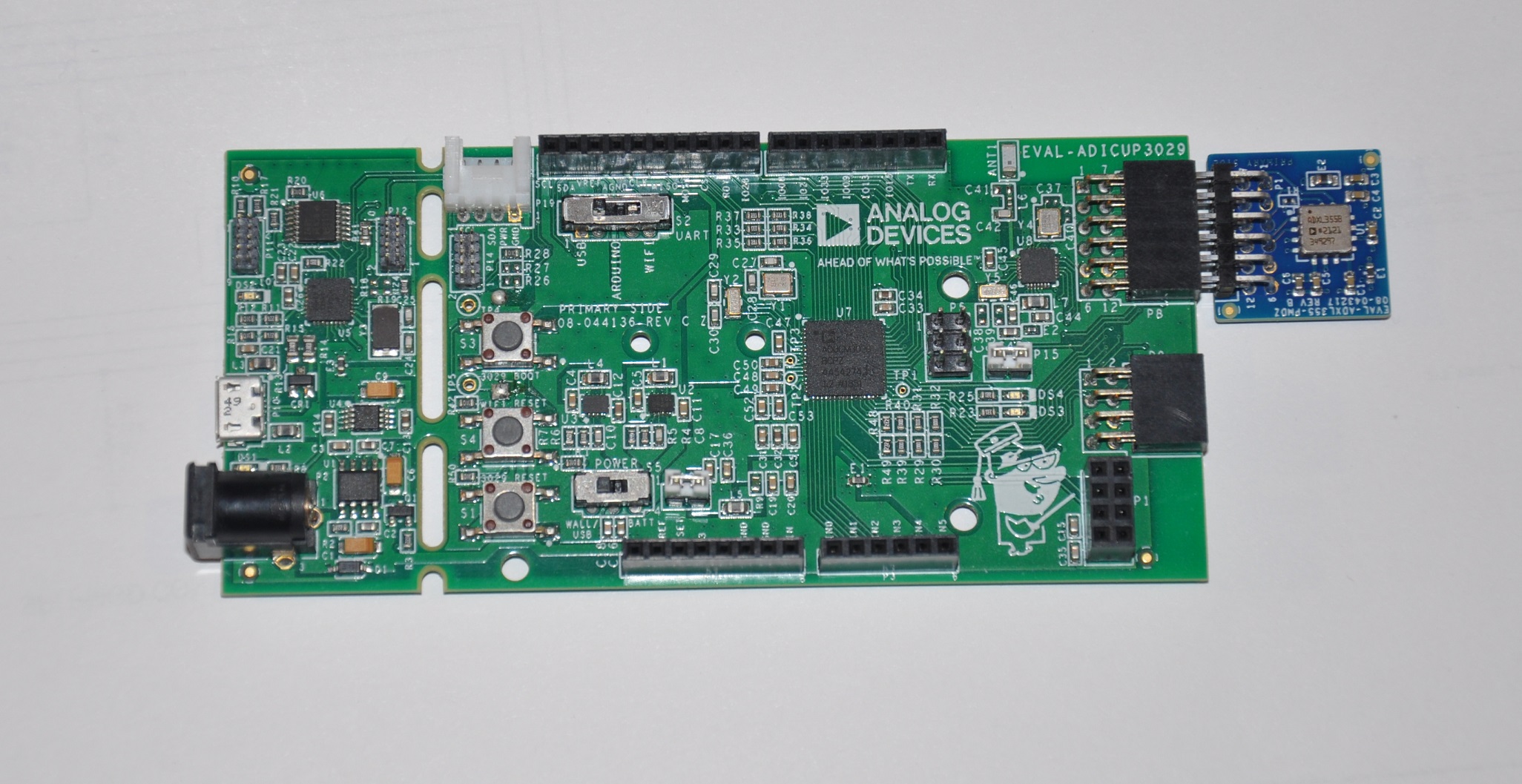
Make sure the following switches are as shown from the table below.

From your PC, open My Computer and look for the DAPLINK drive, if you see this then the drivers are complete and correct.

Drag and drop the eval-adxl355-pmdz_aducm3029_iio_example.hex file to the DAPLINK drive and your ADICUP3029 board will be programmed. The DS2 (red) LED will blink rapidly.
The DS2 will stop blinking and will stay ON once the programming is done.
For demo purposes, place the board horizontally such that the Z-axis reading will be approximately 9.8 m/s^2.
System Setup Using MAX32655FTHR or MAX32650FTHR
The EVAL-ADXL355-PMDZ can be used with the MAX32655FTHR or MAX32650FTHR.
Demo Requirements
The following is the list of items needed in order to replicate this demo.
Hardware
MAX32655FTHR or MAX32650FTHR with MAX32625PICO
Micro-USB to USB Cable
10-pin ribbon cable
PC or Laptop with USB Port
Software
For MAX32655FTHR, programming file from zip:
For IIO / libiio: eval-adxl355-pmdz_maxim_iio_example_max32655_adxl355.hex
For terminal CLI: eval-adxl355-pmdz_maxim_dummy_example_max32655_adxl355.hex
For MAX32650FTHR,
For IIO / libiio: eval-adxl355-pmdz_maxim_iio_example_max32650_adxl355.hex
For terminal CLI: eval-adxl355-pmdz_maxim_dummy_example_max32650_adxl355.hex
MAX32655FTHR
1. Connect MAX32655FTHR with the FTHR-PMOD-INTZ. Note that MAXIM feather board should have stacking headers for feather board where the interposer board will be connected.
Connect EVAL-ADXL355-PMDZ to the FTHR-PMOD-INTZ.
Power up the MAX32655FTHR by connecting it to your laptop using micro-USB
4. Open the file explorer. Drag-and-drop the pre-built hex file to the DAPLINK. If the transfer was not completed, update the firmware for the DAPLINK. Follow the steps here: https://github.com/MaximIntegrated/max32625pico-firmware-images/
5. Open PuTTY or other similar software. Check the Device Manager to set correct COM for the MAX32655FTHR. Set baud rate according to hex file used:
Hex file |
Baud rate |
|---|---|
eval-adxl355-pmdz_maxim_dummy_example_max32655_adxl355 |
57600 |
eval-adxl355-pmdz_maxim_iio_example_max32655_adxl355 |
115200 |
eval-adxl355-pmdz_maxim_iio_trigger_example_max32655_adxl355.hex |
115200 |
The final setup should look similar to the picture below.
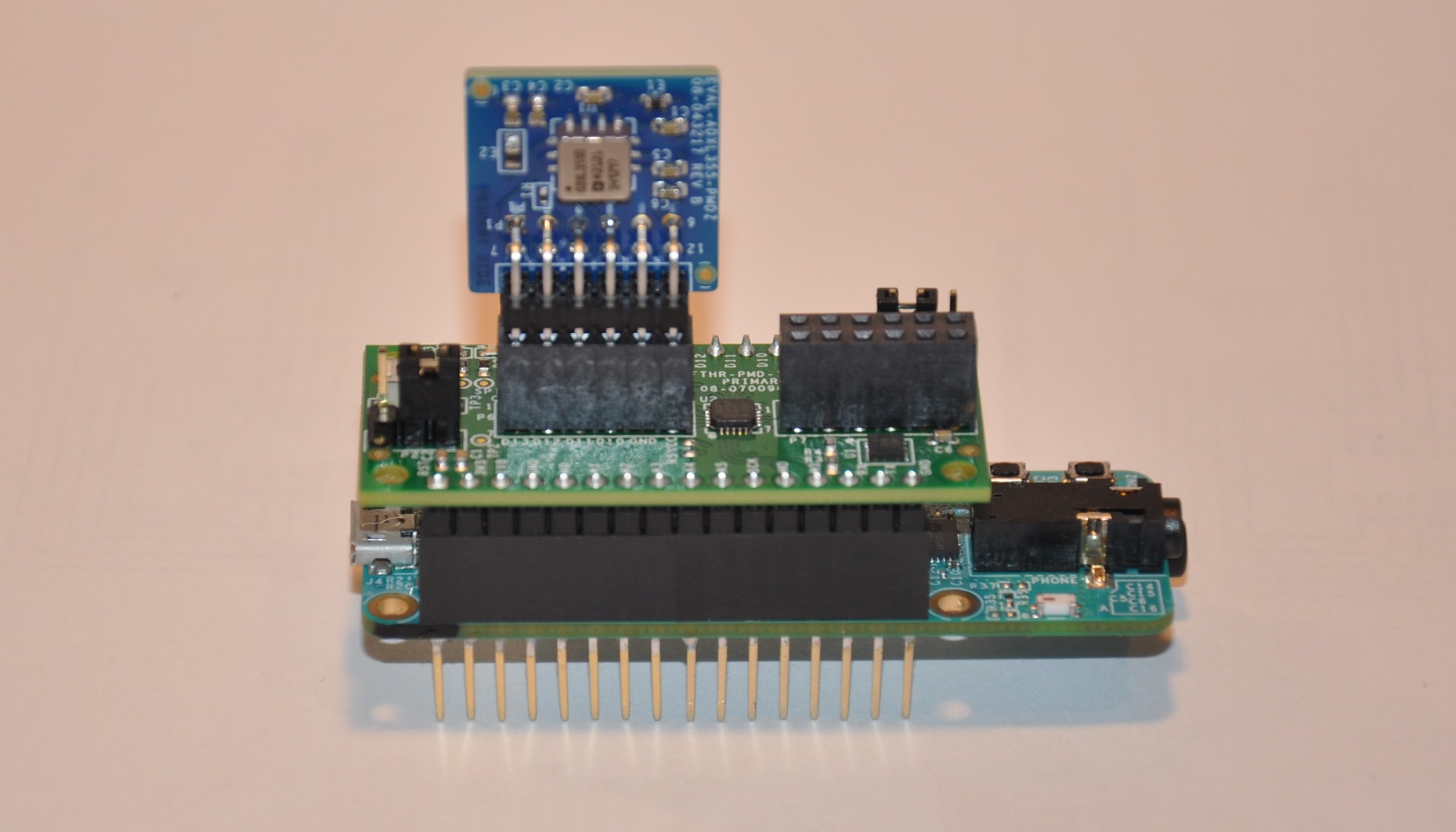
MAX32650FTHR
Using a 10-pin ribbon cable, connect the MAX32625PICO to the MAX32650FTHR.

Connect MAX32650FTHR to the FTHR-PMOD-INTZ.
Connect EVAL-ADXL355-PMDZ to the FTHR-PMOD-INTZ.
MAX31855PMB1
FTHR-PMOD-INTZ SPI
Pin 1 (Chip Enable)
CS
Pin 2 (Not connected)
MOSI
Pin 3 (MISO)
MISO
Pin 4 (SCK)
SCK
Pin 5 (GND)
GND
Pin 6 (VCC)
VCC
The final setup should look similar as shown below.
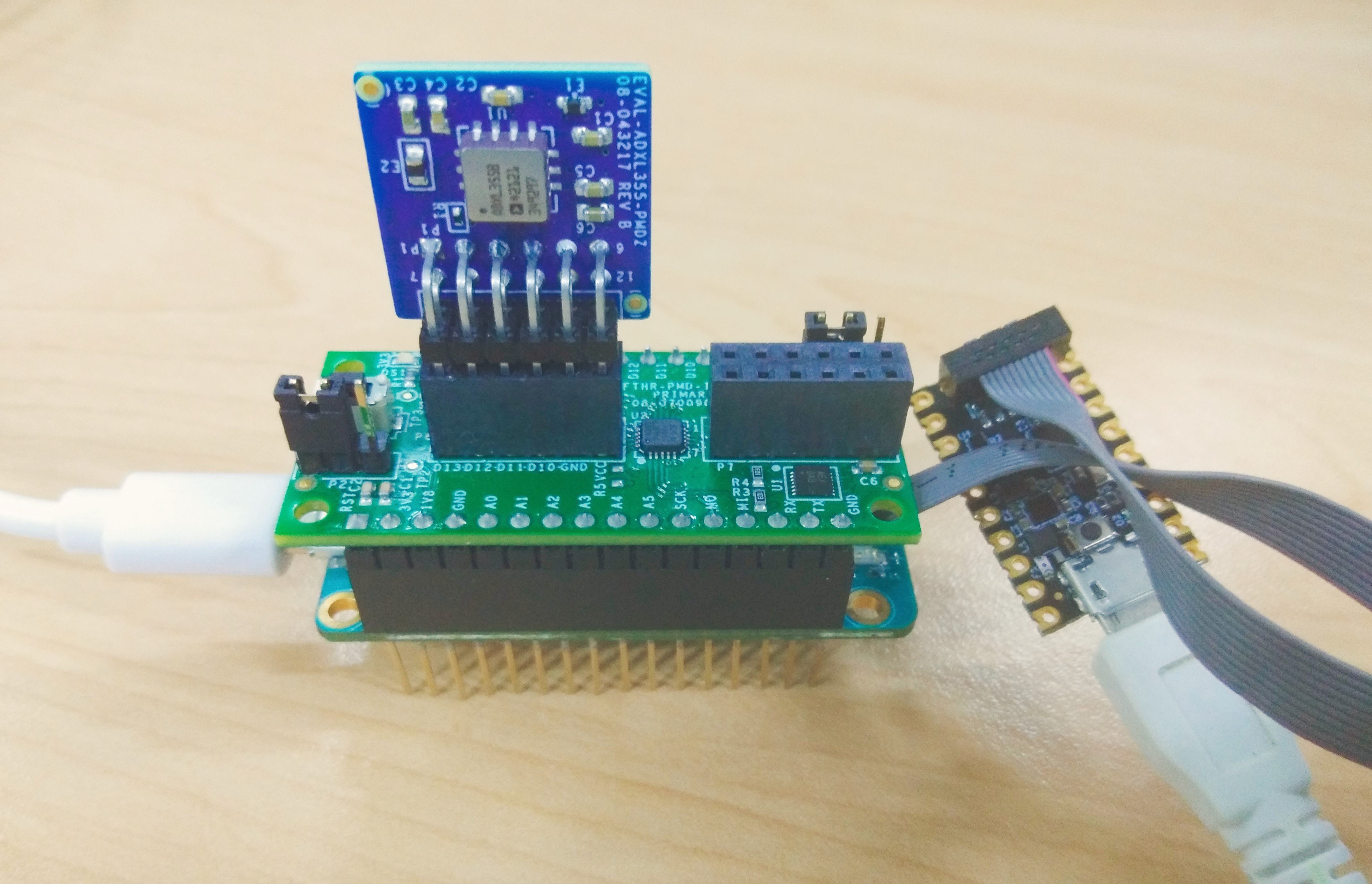
Power up the MAX32650FTHR by connecting it to your laptop using micro-USB. Connect MAX32625PICO to your laptop as well.
Open the file explorer. Drag-and-drop the pre-built hex file to the DAPLINK. If the transfer was not completed, update the firmware for the DAPLINK. Follow the steps here: https://github.com/MaximIntegrated/max32625pico-firmware-images/
Open PuTTY or other similar software. Check the Device Manager to set the correct COM port for the MAX32650FTHR.
Set baud rate according to the hex file used available in MAX32650FTHR_demo_ADXL355.hex:
Hex file |
Baud rate |
|---|---|
eval-adxl355-pmdz_maxim_dummy_example_max32650_adxl355 |
57600 |
eval-adxl355-pmdz_maxim_iio_example_max32650_adxl355 |
115200 |
The expected output viewed in the PuTTY is shown below.
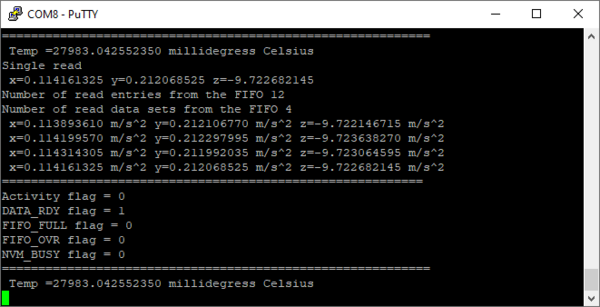
System Setup Using Raspberry Pi
The EVAL-ADXL355-PMDZ can be used with a Raspberry Pi.
Demo Requirements
The following is a list of items needed in order to replicate this demo.
Hardware
Raspberry PI Zero, Zero W, 3B+, or 4
16GB (or larger) Class 10 (or faster) micro-SD card
5Vdc, 2.5A power supply with micro USB connector (USB-C power supply for Raspberry Pi 4)
User interface setup (choose one):
HDMI monitor, keyboard, mouse plugged directly into Raspberry Pi
Host Windows/Linux/Mac computer on the same network as Raspberry Pi
Software
Loading Image on SD Card
In order to boot the Raspberry Pi and control the EVAL-ADXL355-PMDZ, you will need to install ADI Kuiper Linux on an SD card. Complete instructions, including where to download the SD card image, how to write it to the SD card, and how to configure the system are provided on the Kuiper Linux.
Configuring the SD Card
Follow the configuration procedure under Configuring the SD Card for Raspberry Pi Projects at SD Card flashing, substituting the following lines in config.txt:
dtoverlay=rpi-adxl355
Setting up the Hardware
To set up the circuit for evaluation, consider the following steps:
Connect the P9 of the PMOD to Raspberry Pi Interposer board at the male header GPIO pin connector of the Raspberry Pi as shown below.
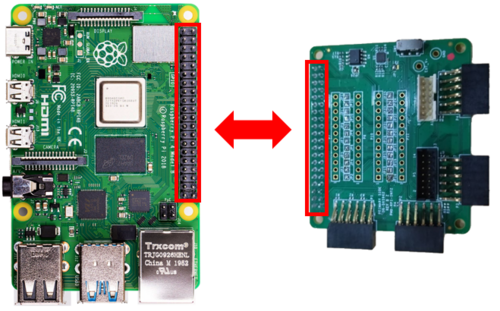
Connect the EVAL-ADXL355-PMDZ on the PMOD to Raspberry Pi Interposer board either via Port P1 or P2.
Burn the SD card with the proper ADI Kuiper Linux image. Insert the burned SD card on the designated slot on the RPi.
Connect the system to a monitor using an HDMI cable through the mini HDMI connector on the RPi.
Connect a USB keyboard and mouse to the RPi through the USB ports.
Power on the RPi board by plugging in a 5V power supply with a micro-USB connector. The final setup should look similar to the picture below.

System Setup Using EVAL-ADICUP360 (DEPRECATED)
The original software example for the ADXL355 was developed on the ADICUP360 platform, and is a simple, terminal-based command line interface. This type of example program is being deprecated in favor of tinyiiod-based servers for embedded platforms, however this example is still available for reference here: ADXL355 Accelerometer PMOD Demo on ADICUP360.
Important
In order to use the EVAL-ADXL355-PMDZ with the ADICUP360, the user MUST remove resistor R1. The ADXL355 holds the DATA_RDY pin low during powerup, and that holds the EVAL-ADICUP360 in UART boot mode. When this mode is active the MCU will stay in standby mode till it receives the proper command, effectively making the ADuCM360 not run. So to avoid this, please remove R1 and note that you can’t use the DATA_RDY pin with the ADICUP360.
Note
Note that the libiio, iio oscilloscope, and pyadi-iio sections below do NOT apply to this example.
Application Software (All Platforms)
The Libiio is a library used for interfacing with IIO devices and is required to be installed on your computer.
Download
Download and install the latest Libiio package on your machine.
To be able to connect your device, the software must be able to create a context. The context creation in the software depends on the backend used to connect to the device as well as the platform where the EVAL-ADXL355-PMDZ is attached. Two platforms are currently supported for the EVAL-ADXL355-PMDZ: Raspberry Pi using the ADI Kuiper Linux and the ADICUP3029 running the no-OS ADXL355 demo project. The user needs to supply a URI which will be used in the context creation.
The iio_info command is a part of the libIIO package that reports all IIO attributes.
Upon installation, simply enter the command on the terminal command line to access it.
For RPI Direct Local Access:
~$
iio_info
For Windows machine connected to Raspberry Pi:
~$
iio_info -u ip:<ip address of your ip>
For example, if your Raspberry Pi has the IP address 192.168.1.7, then enter:
~$
iio_info -u ip:192.168.1.7
Note
Do note that the Windows machine and the RPI board should be connected to the same network in order for the machine to detect the device.
For Windows machine connected to ADICUP3029:
~$
iio_info -u serial:<serial port>
Examples:
In a Windows machine, you can check the port of your ADICUP3029 via Device Manager in the Ports (COM & LPT) section. If your device is in COM4, enter:
~$
iio_info -u serial:COM4
On a Unix-based machine, you will see it under the /dev/ directory in this format “ttyUSBn”, where n is a number depending on how many serial USB devices attached. If you see that your device is ttyUSB0, enter:
~$
iio_info -u serial:/dev/ttyUSB0
IIO Commands
There are different commands that can be used to manage and control the device being used. The iio_attr command reads and writes IIO attributes.
~$
iio_attr [OPTION]...
To look at the context attributes, enter the following command on the terminal:
~$
iio_attr -a -C
The iio_reg command reads or writes SPI or I2C registers in an IIO device. This is generally not needed for end applications, but can be useful in debugging drivers. Note that you need to specify a context using the -u qualifier when you are not directly accessing the device via RPI or when you are using the ADICUP3029 platform.
~$
iio_reg -u <context> <device> <register> [<value>]
To read the device ID (register = 0x02) of an ADXL355 interfaced via RPI from a Windows machine, enter the following code on the terminal:
~$
iio_reg -u ip:<ip address> adxl355 0x02
IIO Oscilloscope
Download and install the latest version of IIO Oscilloscope from: IIO Oscilloscope Installers.
Once done with the installation or an update of the latest IIO Oscilloscope, open the application. The user needs to supply a URI which will be used in the context creation of the IIO Oscilloscope and the instructions can be seen from the previous section. Press refresh to display available IIO Devices, once ADXL355 appeared, press connect.

Debug Panel
Below is the Debug panel of ADXL355 wherein you can directly access the attributes of the device.
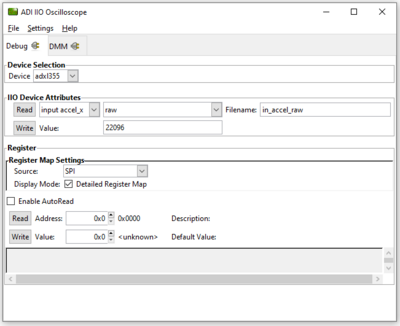
DMM Panel
Access the DMM panel to see the instantaneous reading of the x, y and z axis acceleration readings and the device temperature.
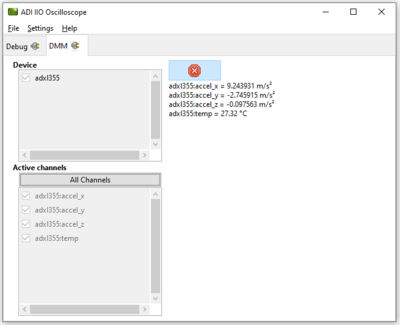
PyADI-IIO
PyADI-IIO is a python abstraction module for ADI hardware with IIO drivers to make them easier to use. This module provides device-specific APIs built on top of the current libIIO python bindings. These interfaces try to match the driver naming as much as possible without the need to understand the complexities of libIIO and IIO.
Follow the step-by-step procedure on how to install, configure, and set up PYADI-IIO and install the necessary packages/modules needed by referring to this link.
Running the example
After installing and configuring PYADI-IIO in your machine, you are now ready to run python script examples. In our case, run the adxl355_example.py found in the examples folder.
Note
Github link for the python sample script: ADXL355 Python Example
Running directly on the RPi
D:\pyadi-iio\examples>
python adxl355_example.py
Press enter and you will get these readings.

For No-OS
D:\pyadi-iio\examples>
python adxl355_no_os_example.py serial:<serial port>,57600
In a Windows machine, you can check the port of your MAX32655FTHR and MAX32650FTHR via Device Manager in the Ports (COM & LPT) section. If your device is in COM8, you have to use:
~$
python pyadi-iio/examples/adxl355_no_os_example.py serial:COM8,57600
Press enter and you will get these readings.

More information and useful links
Schematic, PCB Layout, Bill of Materials
Download
EVAL-ADXL355-PMDZ Design & Integration Files
Schematics
Bill of Materials
Gerber Files
Assembly Files
Allegro Layout File
Additional Information
Hardware Registration
Tip
Receive software update notifications, documentation updates, view the latest videos, and more when you register your hardware. Register to receive all these great benefits and more!